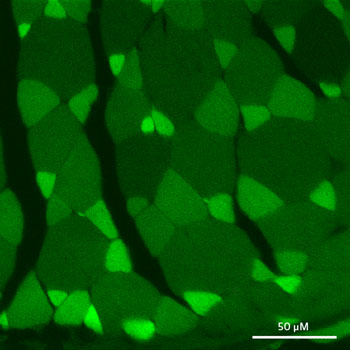Fluorescent Protein Detects Bilirubin in Newborns
By MedImaging International staff writers
Posted on 20 Jul 2016
UnaG, a fluorescent protein sourced from Japanese freshwater eel muscles, can be used to accurately detect unconjugated bilirubin in newborns, according to a new study.Posted on 20 Jul 2016
Developed by researchers at Kobe University (Japan) and the RIKEN Center for Developmental Biology (Kobe, Japan), UnaG can measure the concentration of unconjugated bilirubin in the blood at a sensitivity 10,000 times that of conventional methods. In clinical trials, the UnaG method showed highly positive correlation with bilirubinoxidase (the current conventional method), and is not affected by phototherapy or interference from conjugated bilirubin, hemoglobin, or lipids.

Image: UnaG fluorescent protein in eel muscle fibers (Photo courtesy of RIKEN).
The study, which analyzed 140 serum samples from 92 newborns, including 35 samples from infants receiving phototherapy, found that just one microliter of blood was sufficient to perform the test, especially useful in newborn patients who can only give limited blood samples. The researchers are also planning to develop a simpler analysis kit that can be used in clinical practice, revolutionizing the monitoring of jaundice in newborn infants. The study was published on June 21, 2016, in Scientific Reports.
“High-performance liquid chromatography is the only method for directly measuring unconjugated bilirubin, but is impractical for routine clinical use,” concluded lead author Sota Iwatani, MD, of the department of pediatrics at Kobe University. “The recently cloned UnaG fluorescent protein from eel muscle specifically binds to the unconjugated, but not the conjugated, form of bilirubin with high affinity. Our findings demonstrate that the UnaG method is highly specific and sensitive and can be useful in a clinical setting.”
Kernicterus, or bilirubin-induced neurologic dysfunction, is a brain disorder caused by bilirubin neurotoxicity during the neonatal period. The disease has a worldwide prevalence, and its incidence is increasing in developed countries due to the higher survival rates of extremely preterm infants. And although assessment of total bilirubin levels in serum/plasma is the current gold standard for identifying newborns at risk of kernicterus, it is not the most accurate indicator, since it includes both unconjugated and conjugated bilirubin.
Related Links:
Kobe University
RIKEN Center for Developmental Biology














